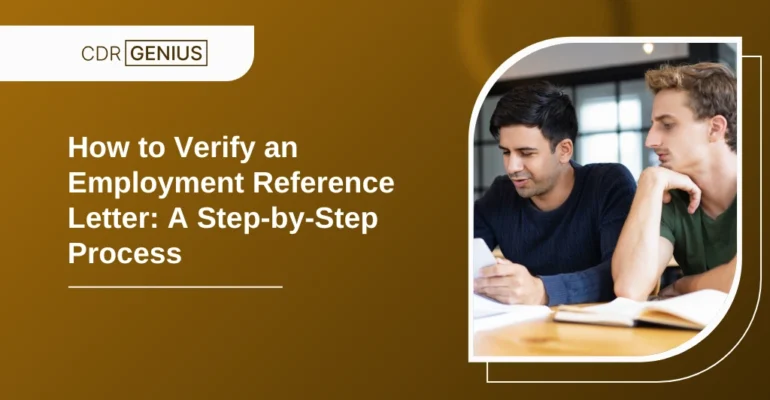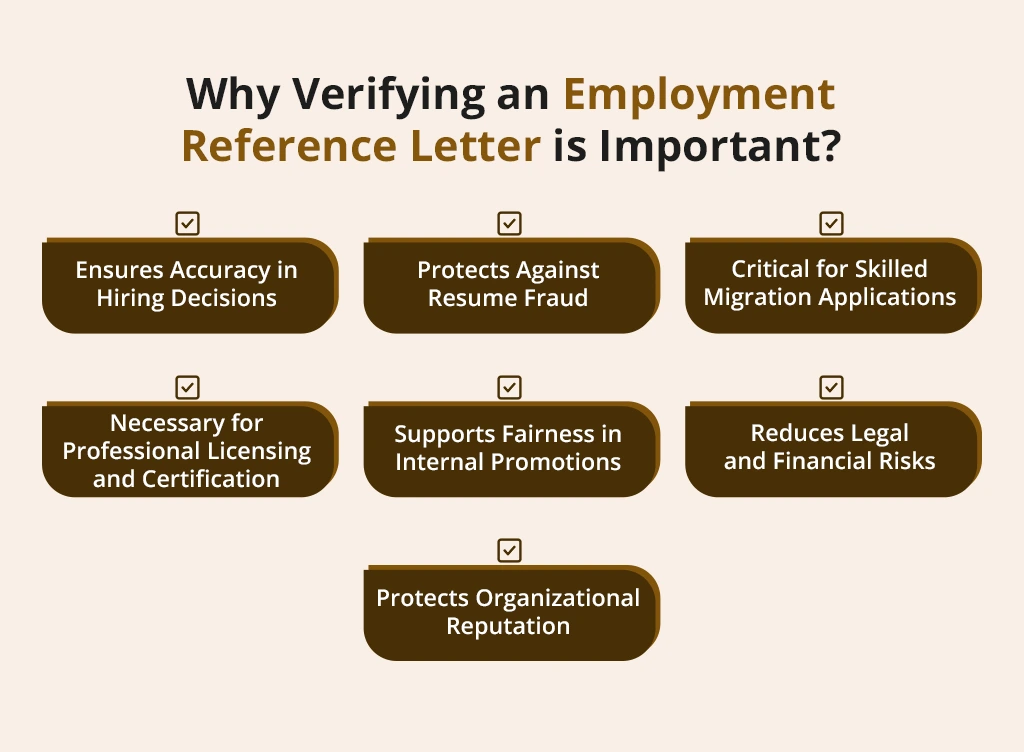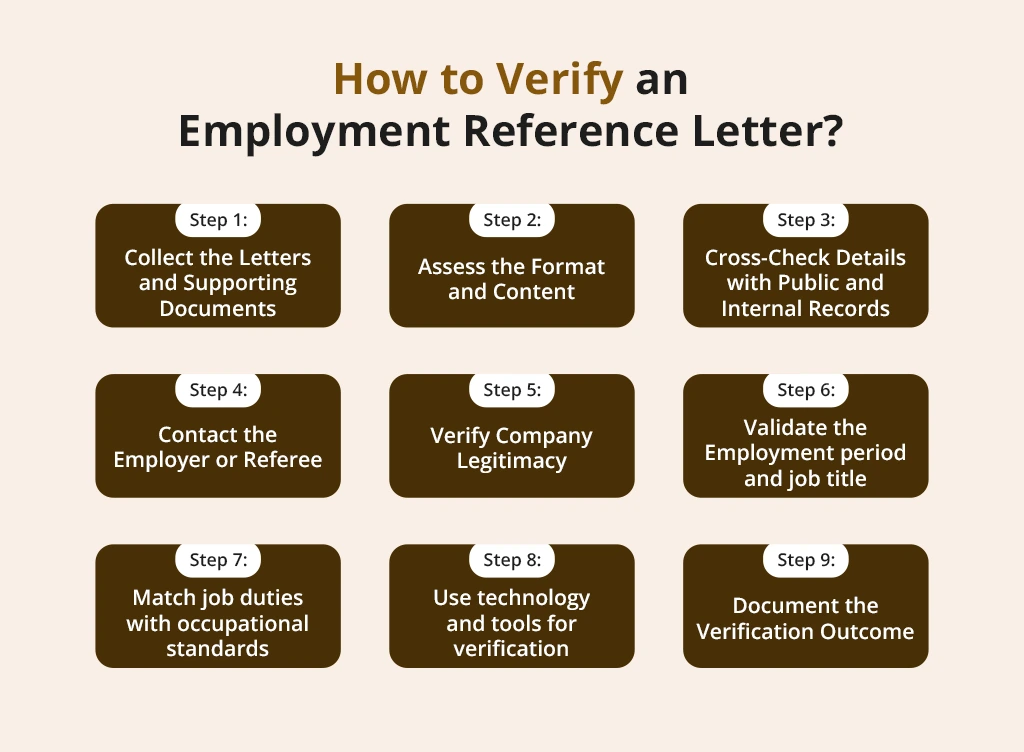How to Verify an Employment Reference Letter: A Step-by-Step Process

How to Verify an Employment Reference Letter: A Step-by-Step Process
An employment reference letter is a crucial document that supports applicants during job applications, skilled migration processes, and professional registration assessments. Because it authenticates a candidate’s work history, you can verify this document at all stages of employment selection, including applications, skilled migration, and professional registration, through organisations such as Engineers Australia and the Australian Computer Society.
This comprehensive guide outlines a step-by-step process for verifying employment reference letters, ensuring credibility, and fulfilling institutional and immigration requirements.
🔑 Key Highlights
- The Employment Reference Letter is proof of your qualified occupational background to meet Australian immigration processes.
- Validates Experience: The Employment Reference Letter presents both job responsibilities and descriptions of duties plus start/end dates of employment.
- Prevents Fraud: The verification of the letter functions as a protective measure against recruiting risks as well as fake job claims.
- Boosts Migration Success: The Employment Reference Letter serves as proof for Australian Immigration requirements when it complies with ANZSCO standards.
What Is an Employment Reference Letter?
Employers or managers use employment reference letters to verify your work connection with their organisation through official documentation. A reference letter from employment combines information about your title and work dates, as well as job tasks and possible accomplishments you achieved.
The reference letter serves as a testament to your work history, providing new employers, educational institutions, and government agencies with the necessary information for immigration or visa purposes.
Why Verifying an Employment Reference Letter is Important?

The process of checking employment reference letters serves as a fundamental practice to protect the integrity of diverse institutional operations. Any professional process that requires employment verification serves as protection against fraudulent and misrepresented information during the hiring process, as well as in migration applications, certifications, and internal promotion decisions. Primary reasons exist for this verification requirement, along with the following details:
1. Ensures Accuracy in Hiring Decisions
The recruiting process succeeds only when employers can validate all requirements stated by job candidates. A confirmation check on reference letters prevents employers from hiring underqualified candidates who often demonstrate insufficient work performance, which may require termination.
Verification of this document enables hiring organisations to identify an applicant’s professional roles and responsibilities during employment, thus allowing them to make wise recruitment choices.
2. Protects Against Resume Fraud
The practice of resume fraud occurs frequently, despite most people being unaware of its extent. Conflict arises when candidates either exaggerate their job responsibilities beyond reality, claim false job titles, or provide misleading employment information.
Reference letter verification provides organisations with verification, thus protecting them from encountering resume deception. The document provides employers with proof that the candidate’s employment history aligns with what it should be, without any fabricated enhancements for personal gain.
3. Critical for Skilled Migration Applications
The immigration departments, along with assessing bodies such as Engineers Australia, the Australian Computer Society (ACS), and VETASSESS, require job reference letters from visa candidates that provide precise and honest information.
Internal departments, along with assessing bodies such as Engineers Australia, among others, utilise these letters to determine whether candidates’ employment records are genuine and applicable. The verification of an employment reference letter is crucial for visa application acceptance, as falsified documentation can lead to rejection and potential bans, which may trigger legal action against the candidate.
4. Necessary for Professional Licensing and Certification
Different professional licensing authorities need to demonstrate appropriate work experience before granting certification approval. Work references are necessary for chartered status applications by engineers and CPA certification requirements for accountants. Authorities are unable to establish that applicants fulfill the required standards when verification procedures are not properly executed, resulting in certifications being denied.
5. Supports Fairness in Internal Promotions
Reference letters from supervisors form an essential part of employee transfers between departments or promotions in modern business organisations. False or dishonest endorsements through this system produce unjustified benefits along with organisational disputes. Verification processes help establish promotions through actual achievement recognition, thus creating an honest working atmosphere based on transparency.
6. Reduces Legal and Financial Risks
Assessing an employee by relying on fake reference letters during the hiring process or endorsing current staff can result in expensive legal actions and severe financial penalties.
An employer remains responsible for damages resulting from an unqualified employee, whether the damage involves financial errors, data breaches, or medical mishaps. The verification process minimises such risks through verification of employees’ qualified backgrounds and specialised experiences for their respective roles.
7. Protects Organisational Reputation
The discovery of hiring workers through false credentials will damage an organisation’s professional standing. Public scandals, alongside media exposure, cause significant damage to trust within clients as well as partners and stakeholders of the organisation. The verification process of reference letters enables organisations to safeguard their image, as it demonstrates their commitment to responsible staffing and fair corporate management standards.
How to Verify an Employment Reference Letter?

Employers, migration officers, and credential evaluators must jointly conduct thorough assessments of employment reference letter authenticity. To perform verification properly, I will provide you with step-by-step instructions below:
Step 1: Collect the Letters and Supporting Documents
To initiate the verification process, obtain all candidate-related documents. Employers should verify reference letters by collecting the job reference document and candidate documents, alongside employment contract details, accepted offers, salary statements, and corresponding emails and tax records.
Examining these documents together enables you to view the person’s job history as a whole. Your ability to compare information across multiple documents enables pivotal checks for accuracy, as well as the quick identification of concerning points at the beginning of your review.
Step 2: Assess the Format and Content
Inspect the letter’s design along with its word arrangement after obtaining it. The comfort in the authenticity of the employment reference letter stems from its printed appearance on corporate letterhead, featuring a substantial company logo alongside the letter’s issue date. The document should feature a complete reference statement containing both their full name and professional title, as well as all contact details.
Step 3: Cross-Check Details with Public and Internal Records
The following action involves comparing reference letter data with public sources and company databases. The employee’s LinkedIn profile should be reviewed to verify whether their work experience aligns with the information provided in the reference letter. The company website should be visited to test both the business’s presence and the referee’s accuracy. The info needs verification through searches in news publications and company press releases.
Step 4: Contact the Employer or Referee
A personal discussion with the listed employer or referee stands as the most reliable method to validate the credibility of a reference letter. Utilize company resources to contact referees, as reaching them through specific email addresses or business phone numbers listed on the official website is the most reliable method.
Engage in polite conversations to verify both the employee’s position and the time they have been working there, while ensuring the author of the letter corresponds to the referee. A formal email is suitable for immigration or academic evaluations, provided you keep a record of every communication.
Step 5: Verify Company Legitimacy
The production of false reference letters stems from fraudsters who establish completely counterfeit enterprises solely to generate these fictitious documents. A company reference requires accurate verification to confirm whether the organisation is registered and authentic.
Verify that the company maintains an active website, displays a physical address validated through Google Maps, and has a presence on social media platforms with available reviews.
Step 6: Validate the Employment period and job title
Reference letters are often altered to reflect changes in employment start and end dates or job positions. Cross-reference both employment dates with bank records and employment documentation, which include pay stubs, tax returns, and professional contracts. Application experience, in conjunction with industry norms, should align with the stated job title.
Step 7: Match job duties with occupational standards
Migration and professional licensing cases heavily depend on this particular evaluation process. Migration organisations, such as Engineers Australia or the Australian Computer Society (ACS), evaluate professional reference letters through their alignment with professional standards, which include the Australian and New Zealand Standard Classification of Occupations (ANZSCO) for Australia and the National Occupational Classification (NOC) for Canada.
Step 8: Use technology and tools for verification
Technology tools provide ease of verification in today’s working processes. You should verify work histories through LinkedIn while also finding mutual connections on the platform. Users can confirm contact numbers and email domains through Truecaller and WHOIS platforms. Google Reverse Image Search allows users to identify when logos or referee signatures originated from the public internet.
Step 9: Document the Verification Outcome
After verification is complete, you need to create detailed documentation of all findings. Document verification needs to become vital for organisations that require documented proof, as well as for immigration departments and credentialing bodies. Maintain a list that verifies details, along with pictures or screenshots of all checked online sources, as well as email exchanges, call records, and your final rating.
Conclusion
Verification of employment reference letters serves as an essential process that safeguards against fraudulent activities while upholding professional ethics for informed recruitment decisions, as well as skilled migration processing and licensing, and promotional decisions. Professionals who verify reference letters as part of their work must conduct comprehensive assessments to avoid both financial and legal consequences, as well as reputation complications.
Accurate document verification and resume evaluation are essential requirements in modern times, as forgers operate at professional levels, making this practice a necessity. Following established verification procedures coupled with vigilance towards warning signs exempts your organisation from reputation damage while identifying qualified candidates. A thoroughly checked verification system represents both professionalism and organisational transparency as well as integrity.
FAQs
1. How do you verify a reference letter?
Verification of reference letters requires evaluating the document format and content, as well as validating the employer organisation and employment information from official records, while using employer-provided contact details for further confirmation.
2. How do I process employment verification?
The processing of employment verification requires you to obtain reference letters together with supporting documents while reviewing the job specifics, along with verifying the employer’s existence through direct communication with the referee before documenting all results for future use.
3. How do I check if a reference is correct?
You can verify references through checks on job descriptions, as well as company validity and personal conversations with referees.
4. How long does it take to verify references?
Verification of references usually takes two to five business days.
5. Can you use HR as a reference?
Yes, you can use HR as a reference.
 Chat with us
Chat with us